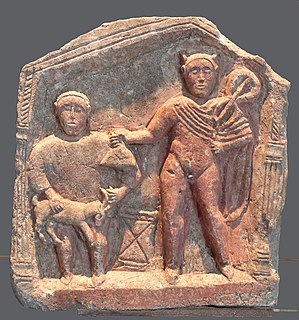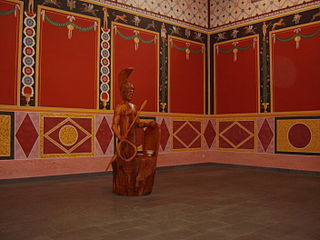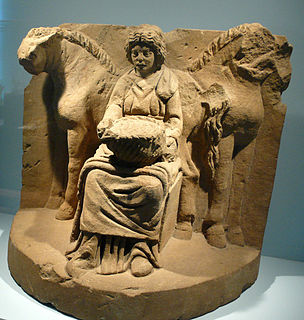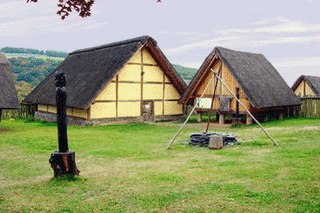
Mercury is a major god in Roman religion and mythology, being one of the 12 Dii Consentes within the ancient Roman pantheon. He is the god of financial gain, commerce, eloquence, messages, communication, travelers, boundaries, luck, trickery and thieves; he also serves as the guide of souls to the underworld. He was considered the son of Maia, who was a daughter of the Titan Atlas, and Jupiter in Roman mythology. His name is possibly related to the Latin word merx, mercari, and merces (wages); another possible connection is the Proto-Indo-European root merĝ- for "boundary, border" and Greek οὖρος, as the "keeper of boundaries," referring to his role as bridge between the upper and lower worlds. In his earliest forms, he appears to have been related to the Etruscan deity Turms; both gods share characteristics with the Greek god Hermes. He is often depicted holding the caduceus in his left hand. Similar to his Greek equivalent Hermes, he was awarded the caduceus by Apollo who handed him a magic wand, which later turned into the caduceus.

In Gallo-Roman religion, Ancamna was a goddess worshipped particularly in the valley of the Moselle River. She was commemorated at Trier and Ripsdorf as the consort of Lenus Mars, and at Möhn as the consort of Mars Smertulitanus. At Trier, altars were set up in honour of Lenus Mars, Ancamna and the genii of various pagi of the Treveri, giving the impression of Lenus Mars and Ancamna as tribal protectors honoured in an officially organized cult. Among the few statuettes left as votive offerings left at the sanctuary of Mars Smertulitanus and Ancamna at Möhn is one of a genius cucullatus like those offered to the Xulsigiae at the Lenus Mars temple complex in Trier.

Esus, Hesus, or Aisus was a Gaulish god known from two monumental statues and a line in Lucan's Bellum civile.

In the Celtic polytheism of classical antiquity, Grannus was a deity associated with spas, healing thermal and mineral springs, and the sun. He was regularly identified with Apollo as Apollo Grannus. He was frequently worshipped in conjunction with Sirona, and sometimes with Mars and other deities.
In Gallo-Roman religion, Loucetios was a Gallic god known from the Rhine-Moselle region, where he was invariably identified with the Roman Mars. Scholars have interpreted his name to mean ‘lightning’. Mars Loucetius was worshipped alongside the goddess Nemetona.

Nemetona, or 'she of the sacred grove', is a Celtic goddess with roots in northeastern Gaul. She is thought to have been the eponymous deity of the Germano-Celtic people known as the Nemetes; evidence of her veneration is found in their former territory along the Middle Rhine as well in the Altbachtal sanctuary in present-day Trier, Germany. She is also attested in Bath, England, where an altar to her was dedicated by a man of the Gallic Treveri people.

Nodens is a Celtic deity associated with healing, the sea, hunting and dogs. He was worshipped in ancient Britain, most notably in a temple complex at Lydney Park in Gloucestershire, and possibly also in Gaul. He is equated with the Roman gods Mars, Neptune and Silvanus, and his name is cognate with that of the Irish mythological figure Nuada and the Welsh Nudd.

In Gallo-Roman religion, Smertrios or Smertrius was a god of war worshipped in Gaul and Noricum. In Roman times he was equated with Mars. His name contains the same root as that of the goddess Rosmerta and may mean "The Purveyor" or "The Provider", a title rather than a true name. Smertulitanus may be a variant name for the same god.
In Romano-British culture and Germanic polytheism, the Alaisiagae were a pair of Celtic and Germanic goddesses deifying victory.

Proto-Indo-European mythology is the body of myths and stories associated with the Proto-Indo-Europeans. Although these stories are not directly attested, they have been reconstructed by scholars of comparative mythology based on the similarities in the belief systems of various Indo-European peoples.

Lenus was a Celtic healing god worshipped mainly in eastern Gaul, where he was almost always identified with the Roman god Mars. He was an important god of the Treveri tribe, who had large sanctuaries at medicinal springs at Trier and the Martberg by Pommern in what is now Germany. Two dedications to him are also known from southwestern Britain. Edith Wightman characterizes him as “one of the best examples of a Teutates, or god of the people, equated with Mars—protector of the tribe in battle, but also [...] bestower of health and general good fortune” (p. 211). His sanctuary ‘Am Irminenwingert’ at Trier had a large temple, baths, smaller shrines and a theatre; that on the Martberg also included a large variety of buildings, probably including rooms for health-seeking pilgrims to stay. Despite his associations with healing, Lenus Mars is depicted classically as a warrior with Corinthian helmet in a bronze statuette from the Martberg.

Inciona is a little-known Celtic goddess of the Treveran region. Her name is recorded as one of a pair of deities on two votive inscriptions from Luxembourg.

Veraudunus is the name of a Celtic god known only from two votive inscriptions found in Luxembourg. One of these inscriptions suggests that ‘Veraudunus’ may have been an epithet of the important Treveran god Lenus Mars. In both inscriptions, Veraudunus is invoked along with Inciona.
Ocelus is a celtic god known from three inscriptions in Roman Britain. He is twice invoked on dedications at Caerwent: one stone is the base of a statue of which only a pair of human feet and a pair of goose feet survive. The invocation is to Mars Lenus or Ocelus Vellaunus and the "numen" (spirit) of the emperor, and was dedicated on 23 August AD 152. The second Caerwent inscription dedicates an altar to Mars Ocelus. The god was also venerated at Carlisle, where he was once more equated with Mars and again linked to the imperial cult. So Ocelus seems to have been a British, perhaps Silurian god, associated with Mars, probably in the latter's Celtic capacity as a protector. At Caerwent he is linked with Lenus, a Treveran healing deity, and with Vellaunus, who is recorded among the Gaulish Allobroges.
Vellaunus is a Celtic god known from only two inscriptions. The first, found at Caerwent, is the base of a state recording the dedication of the statue to:
Toutatis or Teutates is a Celtic god who was worshipped in ancient Gaul and Britain. On the basis of his name's etymology, he has been widely interpreted to be a tribal protector.

The gods and goddesses of the pre-Christian Celtic peoples are known from a variety of sources, including ancient places of worship, statues, engravings, cult objects and place or personal names. The ancient Celts appear to have had a pantheon of deities comparable to others in Indo-European religion, each linked to aspects of life and the natural world. By a process of synthesism, after the Roman conquest of Celtic areas, these became associated with their Roman equivalent, and their worship continued until Christianization. Ancient Celtic art produced few images of deities, and these are hard to identify, lacking inscriptions, but in the post-conquest period many more images were made, some with inscriptions naming the deity. Most of the specific information we have therefore comes from Latin writers and the archaeology of the post-conquest period. More tentatively, links can be made between ancient Celtic deities and figures in early medieval Irish and Welsh literature, although all this was produced well after Christianization.

Celtic mythology is the mythology of Celtic polytheism, the religion of the Iron Age Celts. Like other Iron Age Europeans, the early Celts maintained a polytheistic mythology and religious structure. For Celts in close contact with Ancient Rome, such as the Gauls and Celtiberians, their mythology did not survive the Roman Empire, their subsequent conversion to Christianity and the loss of their Celtic languages. It is mostly through contemporary Roman and Christian sources that their mythology has been preserved. The Celtic peoples who maintained either political or linguistic identities left vestigial remnants of their ancestral mythologies that were put into written form during the Middle Ages.















